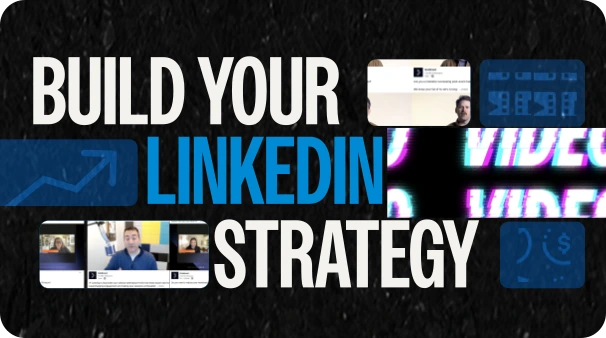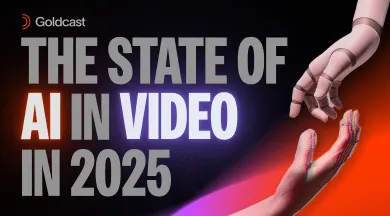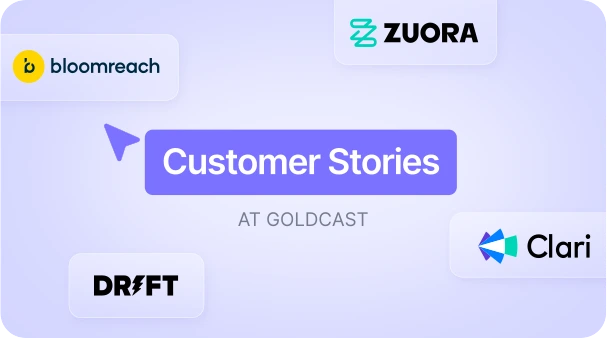Your First AI Purchase, Scaling Follow-Ups, and AI-Powered Gifting Strategies 🥳
Table of Contents
- A few pointers for your first AI purchase
- Infosec: Be wary of Pandora's box
- Manage everyone's expectations when you first start out with AI
- Red flags to watch out for with vendors 🚩
- Scaling account follow-up with AI
- Why speed matters
- How AI personalization informs your gifting strategy
- You still have to pay attention to your leads
- How to measure the success of AI-powered strategies
- This is the time to have fun with AI!
Maximize Your Marketing ROI
Join 10,000 other marketers already getting the best tips on running engaging events that boost pipeline and create raving fans.
The first AI Alliance Summit was packed full of great conversations, covering everything from how to integrate AI throughout the enterprise to the role of AI in the marketing flywheel.
Over the course of three sessions, experts from 6sense, Sendoso, Intelligent Demand, and other companies came together to chat about how to choose your first AI tool, ways AI can scale account-follow up, and how AI personalization plays out in sales and marketing strategies.
Read on to learn:
- A few pointers for your first AI purchase
- Infosec: Be wary of Pandora's box
- Manage everyone's expectations when you first start out with AI
- Red flags to watch out for with vendors 🚩
- Scaling account follow-up with AI
- Why speed matters
- How AI personalization informs your gifting strategy
- You still have to pay attention to your leads
- How to measure the success of AI-powered strategies
- This is the time to have fun with AI!
If you want to learn with other marketing execs about the practical application of AI, check out the AI Marketing Alliance! We'd love to have you join us:
A few pointers for your first AI purchase
On the topic of making your first AI purchase, Aaron Owens, Head of Growth Consulting at Intelligent Demand, spoke with Thomas Rogers, VP, Marketing Technology, Analytics, Research and Operations at Vizient, and Lauren Luen, VP of Operations Transformation at EDB.
Thomas and Lauren are both GTM leaders who have been through the AI purchase cycle at least once and have lots of insights on how to navigate that first AI purchase! Here are some of their best tips.
When you're making your first AI decision, look for ways you can use AI for efficiency in your current processes. Maybe that's creating that first draft of content, or maybe it's spinning up follow-up emails for your sales team. The output will still go to a human for review, but AI can help you get off the starting block much faster.
Some ideas on how to use AI up front:
- Brainstorming for content
- Automating anything that can possibly be automated!
- Scoring leads
- Shortening cycles that have a lot of people involved (repurposing, anyone?)
Pick a tool that fits your company now, not one you have to orient your company around. There are lots of cool AI solutions out there, but don't pick one that doesn't speak directly to a current problem you have within your org. Be sure that the technology and its benefits align to your current journey and that you don't have to pivot the direction you're going in just to plug in an AI tool (no matter how awesome it seems).
It's a good rule of thumb to opt for annual contracts. AI is evolving rapidly, and that first year is a good time period to learn the tool and understand how it works with your business. You'll spend a lot of time that first year fine-tuning the model to get closer to the outputs you want to get, and then you can decide whether to renew the contract.
Infosec: Be wary of Pandora's box
Data security and customer privacy, as well as compliance, are all major considerations with AI tools. AI is still super nascent, and we don't know everything about it yet.
It's a smart approach to bring AI in in a constrained way; for example, don't allow protected information to leave your company servers. Give AI the minimum amount of data it needs to do its job. Start conservative, and you can adjust your approach once you become more comfortable with the tools you've selected.
The purchase review process should also include folks from your legal team so that they can weigh in on the legal implications of a specific tool or platform. (With the caveat that we're all still learning about AI, so it's unlikely your legal experts are super well-versed on AI just yet!)
Manage everyone's expectations when you first start out with AI
As a marketing leader, it's up to you to set the tone for your company around AI adoption. Remember that the goal starting out is to ramp up efficiency and make things happen faster. A major expectation to be set here is that there will always need to be a human touch involved.
Be sure that everyone understands that nothing AI produces is ready to ship. Quite the contrary! Be clear about who needs to review the outputs, and how many people need to review, before anything is ready to go live.
It's also a good idea to be up front about your intentions with AI. Some people will understandably be worried about job security when they hear you're bringing on an AI tool. It's okay to tell folks you have no intention of replacing anyone. Instead, you want AI to make everyone better at their jobs. Hopefully, this approach leads to better engagement and less controversy over AI adoption.
Red flags to watch out for with vendors 🚩
Be wary of any vendor that promises you the world. Again, AI is nascent and companies should be open with you about where they're at with their tools. Demo the tools you're interested in, and ask lots of questions. Be sure you understand how the models are built, how variables are pulled in, and the way the dependencies line up. You should be pretty comfortable with the tool and with the answers you're given along the way as you explore it.
Once you find a tool that you're excited about, act on it quickly if you can. Implementation takes longer than you think, and it'll take even more time to get the model acclimated to your business environment and working toward valuable outputs.
Scaling account follow-up with AI
Once you've selected your AI tools, what's next?
Ernest Owusu, Sr. Director, Sales Development at 6sense, and Michael Brown, Head of Global Business Development at Reltio, talked about how to scale account follow-up using AI tools.
Some terms from this presentation and what they mean at Reltio:
- Speed-based motion, meaning a hand raise that comes in and gives you about six minutes to respond if you want to catch that person still at their desk.
- Signal-based motion, where a buyer signals there's a high propensity to buy. These should also be acted on quickly so you don't lose the deal.
- Reinvigoration: Just because someone came through the funnel and decided not to proceed, that doesn't mean you shouldn't focus on nurturing those accounts.
- Cadence depth: Being sure that the team has executed 9-12+ touches in each account and identified layers-deep personas.
- Hyper-personalization: Crafting persona-specific messaging and touchpoints for each account.
- AI: AI has been oriented toward the age of engagements, at leads that are about 60 days old. As the team becomes more familiar with the tools, they're using it for event leads, follow-up, driving registration, closed/lost engagements, and more.
Why speed matters
When it comes to the speed-based motion, the 6sense team addresses it with conversational email, one of their own products. If you go to a trade show and get thousands of leads, 6sense uses AI to segment those to determine the high-intent leads. Everyone gets followed up with, of course, but the high-intent folks get conversational emails right away that hopefully open up a dialogue and move the deal forward.
Is this immediate follow-up really necessary, though?
In today's attention economy, the answer is yes. If you follow up right after a lead expresses interest or connects with you, they're much more likely to remember you and take action.
At the same time, it's totally fair that your team is not going to have time to do those individual follow-ups at scale, after every single event.
Using AI to write the emails and push out automated communication in the background frees up your team to focus on the areas their expertise is truly needed. No one falls through the cracks, everyone gets followed up with, and your staff get to hone in on the highest impact leads in your system.
How AI personalization informs your gifting strategy
We also heard from Austin Sandmeyer, Head of Growth and Customer Marketing at Sendoso. Austin talked with Suzzette Giron, Account Based Marketing Manager at Invoca, and Alfred Murgado, Director of Marketing Operations at Magaya Corporation. They discussed how to use AI personalization to transform sales and marketing strategies.
First, if you aren't using gifting as part of your strategy, you should be!
Here are the different gifting use cases these marketers discussed:
- Maintaining customer loyalty
- Upselling and increasing customer engagement
- Accelerating deals and pipeline
- ABM motion
With an AI-powered tool like Sendoso, you can use features like SmartSend to figure out which gifts will resonate with each person. The AI tool takes current data on what's trending in the world of gifts, as well as your own specific search keywords, and gives you recommendations on what to send out. Once you select a gift, you can also generate a personalized note card message to send along with it!
You still have to pay attention to your leads
While Sendoso's tools are smart, you still have to be vigilant and pay attention to people. If you're talking to someone and they mention being a fan of a certain show, write that down! Tell your salespeople! Add it to the account notes!
That way, when you send a gift, you're going to remember that info and send them a gift that's going to blow their mind because they can't believe you remembered that one small detail.
How to measure the success of AI-powered strategies
Ultimately, you're probably going to look to revenue when you want to know whether your personalized strategies are working.
Here's what Suzzette and Alfred look at when gauging success:
- Number of opps
- ACV
- How many deals were booked that were influenced with direct mail campaigns
- Account engagement
- Speed-to-close ratio
- Retention
Alfred's seen incredible improvement in the speed-to-close ratio using tactics like gifting. The average sales cycle has gone from 95 days to closer to 30! That's a huge difference and one that is directly related to whether or not each deal had an additional touchpoint via Sendoso gifting.
Retention at Magaya has also skyrocketed. Before, customers reported that after they signed the contract, they felt like they were kind of on their own. They didn't hear from Magaya again. Alfred wanted to fix that, and so the company started an anniversary loyalty program.
Now, people get to redeem gifts when they celebrate an anniversary with Magaya. People love it! And Magaya didn't stop there; they added a gifting-related touchpoint at every pain point during the customer journey—whether it was a handoff point or at the point of renewal, when customers learn there's a rate increase.
This is the time to have fun with AI!
You've learned about how to navigate your first AI purchase, how to scale account follow-up with AI tools, and ways that AI personalization (specifically with gifting) can help you supercharge customer retention and speed-to-close.
As a closing note: Don't forget to have FUN with this stuff. We're at a place where marketing has become stale. We needed a new playbook and new tools—and we've got them! Isn't that amazing? Play around with ways that you can use AI in the tools you're already working with, as well as looking at new tech, and keep an open mind as you go.
Check out the AI Marketing Alliance today to join the network today!
Stay In Touch
Platform
Resources
Company
Community
© 2025 Copyright Goldcast, Inc. All rights reserved.



 Upcoming Events
Upcoming Events Event Series
Event Series On-Demand Events
On-Demand Events

